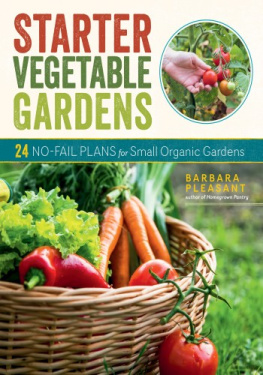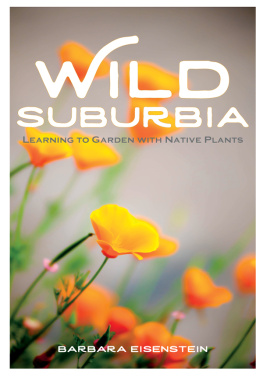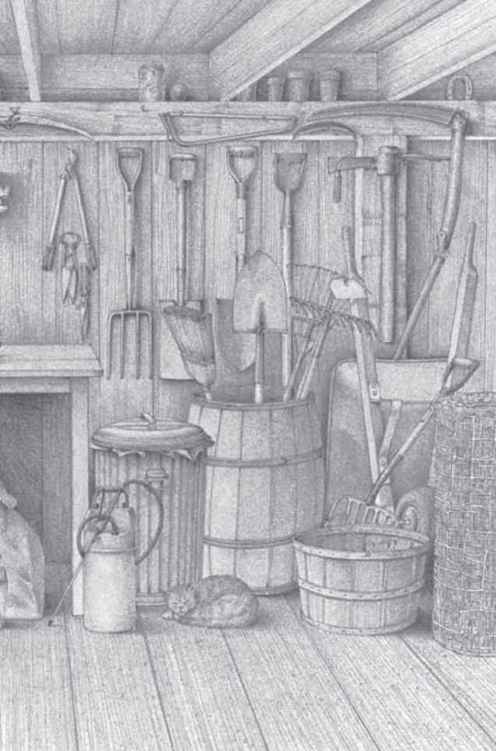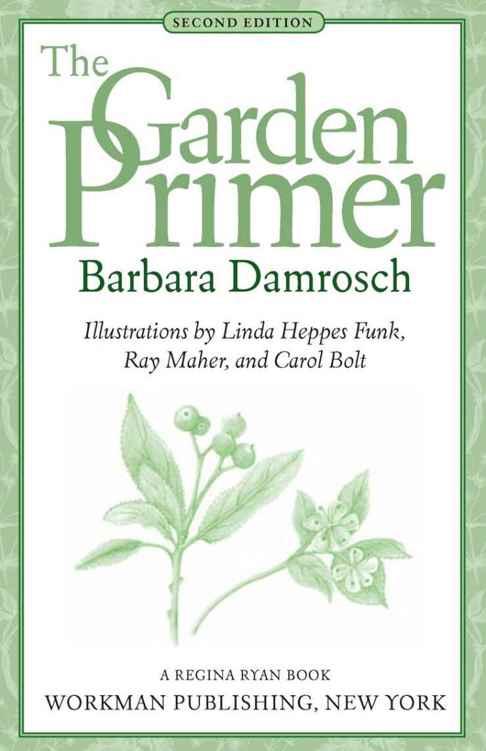Table of Contents
Copyright 2008 Barbara Damrosch and Regina Ryan
All rights reserved. No portion of this book may be reproducedmechanically, electronically, or by any other means, including photocopyingwithout written permission of the publisher. Published simultaneously in Canada by Thomas Allen & Son, Limited.
Library of Congress Cataloguing-in-Publication Data is available.
ISBN-13: 978-0-7611-2275-3 (pb); ISBN-13: 978-0-7611-4856-2 (hc)
Recycled stock; 15% post-consumer waste, acid-free, and manufactured-elemental-chlorine-free.
Grateful acknowledgment is made for permission to reprint: page 373, copyright 1978 by Marge Piercy, reprinted from The Twelve-Spoked Wheel Flashing by Marge Piercy, by permission of Alfred A. Knopf, Inc.; page 385, from Herbs of a Rhyming Gardener by Elisabeth Morss, reprinted courtesy of Branden Publishing Company; page 414, from Beautiful Old Age, The Complete Poems of D. H. Lawrence, ed. Vivian de Sola Pinto and F. Warren Roberts, copyright 1964, 1971 by Angelo Ravagli and C. M. Weekley, Executors of the Estate of Frieda Lawrence Ravagli, all rights reserved, reprinted by permission of Viking Penguin Inc. and Curtis Brown Limited; page 469, William Carlos Williams, Collected Poems, Volume I (1909-1939), copyright 1938 by New Directions Publishing Corporation.
Cover photograph by Matthew Benson
Book design by Barbara Balch
Illustrations by Linda Heppes Funk: pages iii, vii left, viii, 3, 15, 33, 39, 46 lower left, 48 upper left and upper right, 50 lower right, 51 upper right, 64 ant lion, assassin bug, bumblebee, orchard mason bee, ground beetle, braconid wasp, dragonfly, syrphid fly, 81, 82, 89, 95 right-angled trowel, 96, 99 collinear hoe, 109, 119, 131, 138, 140, 147 top right, 151 right, 154 right, 158 left, 160 left, 161 left, 162 left, 165, 180-181, 197, 204 left, 212 right, 215, 216 left, 217, 218, 223 left, 216 left, 244, 246, 266, 334-336, 388, 394, 399-401, 444, 485, 502, 519, 522, 528, 539, 557, 566 left, 568 left, 572 left, 574, 586, 589 left, 590, 592, 597, 600, 602, 622, 626, 628 left, 633 right, 636 left, 639, 647, 649, 651 right, 675 left, 682 left, 684, 685 left, 702 left, 709, 710 right.
Ray Maher: inside front cover, page i, vii right, 41, 53, 73, 94, 95 except right-angled trowel, 97, 99 except collinear hoe, 102-103, 105-106, 108, 111, 114, 116-117, 229, 269, 271, 272, 273, 274, 277, 279, 281, 285, 287, 290, 294, 297-298, 300, 304, 309, 312, 315, 316, 320, 322, 328, 331, 337, 340, 344, 346, 350, 352, 354, 357, 360, 363, 368-370, 373, 375, 377, 380, 383, 411, 414, 429, 432, 436, 440, 449, 457, 462, 466, 469, 472, 480, 575, 653, 689, 715, 716, 755.
All other illustrations by Carol Bolt.
Books are available at special discounts when purchased in bulk for premiums and sales promotions as well as for fund-raising or educational use. Special editions or book excerpts can also be created to specification. For details, contact the Special Sales Director at the address below.
Workman Publishing Company, Inc.
225 Varick Street
New York, NY 10014-4381
www.workman.com
Printed in the United States of America
First printing February 2008
10 9 8 7 6 5 4 3 2 1
To Eliot
Acknowledgments
A number of people made the writing of this book an easier, more pleasant task than it would otherwise have been. Regina Ryan helped to launch the original project, the late Sally Kovalchick saw it through, and the late Paul Frese lent his deep knowledge of plants and gardening. I thank Peter and Carolan Workman for their energy and encouragement, and the fine staff that kept the new book on track: my editor Suzanne Rafer, Barbara Balch, Barbara Peragine, Helen Rosner, Carol White, Ron Longe, Anne Kerman, Wayne Kirn, Robert Vargas, and most especially Mary Wilkinson for her superb and heroic efforts on the books behalf. Linda Heppes Funk drew all the exquisite new illustrations for this edition.
My sisters Anne Damrosch and Eloise Damrosch buoyed my spirits throughout the long process, as did many friends: Sherry Streeter, all the Akiwabas, the wonderful crew at Four Season Farm, Kathleen Beal and the dream team, and the staff of Blue Hill Books in Blue Hill, Maine. I also thank Chris Kerrigan, Melissa Coleman, Clara Coleman, and Ian Coleman, for their wit and forbearance. Joel Walther made the computer behave at crucial times. Lisa Chase helped me to clear much space on my desk. Eliot Colemans knowledge, patience, and good cheer have been the greatest gift of all.
A Note on the Second Edition
T WENTY-TWO YEARS AGO I SAT down to write a simple little book that would introduce people to gardening. If Id known how large it would grow, I might never have begun. Now its 2008 and THE GARDEN PRIMER has grown again. Much of the original needed updatingnew varieties, new sources, more efficient techniques, innovative tools. After a few more decades in my garden and the gardens of others, Id learned much that I wanted to share, and Ive packed as many additional plants into these pages as practicality would allow. Many are North American natives, and a number are suitable for drier conditions, a consideration for any place where water is, or could be, a scarce resourcethat is, everywhere.
The march of gardening commerce is always advancing, as Katherine White so hilariously noted in her essays in The New Yorker (anthologized after her death in the 1977 book Onward and Upward in the Garden ). For better or worse, flowers are commanded to produce more petals, and leaves must evolve in shades beyond green. Some trends, such as the breeding of smaller varieties for smaller yards, are quite practical. Others, such as the genetic engineering of food plants for pest or herbicide resistance, are poor substitutes for good growing practices. But if the pros sometimes disappoint, home gardeners have made great strides. Most of the ones I meet would like to use more sustainable, nontoxic methods, eat from the garden all year, enjoy more wildlife, mow less lawn, avoid invasive species, grow plants better suited to their climates and, in general, make peace with nature rather than fighting her all the way.
On balance, gardeners make the world a better place. So when they show me battered, sun-bleached, mud-spattered copies of my book and tell me it has coaxed them into the garden, I feel that I have done the job I set out to do.
Green Side Up
FIRMLY BELIEVE THAT IN ORDER TO I learn anything you have to be willing to ask dumb questions. People often say to me, I dont know anything about gardening, and some of them just let it go at that. Intimidated by the sheer volume of gardening lore that exists, much of it very scientific and arcane, they leave gardening to those who presumably have lots of time to read and better yet, have a green thumb. But others, unable to resist a pastime they suspect may be a lot of fun, wade right in. I love people who ask things like Why should I prune my plants? or What is mulch?
The aim of this book is to answer as many fundamental questions about gardening as possible. I may not be able to anticipate everything you want to know, but I will explain how pruning can make your plants bushier, more compact, or more fruitful. I will tell you that mulch is a layer of material, such as shredded bark, that you lay down on the ground chiefly to keep weeds from growing and to keep the soil moist. And I will try to come to your aid when youre standing there alone in the garden, holding a plant that looks like an amorphous tangle, and you have no idea what to do with it. If I could go out there with you, I would tell you what my nurseryman friends Mary Ann and Frederick McGourty used to tell their fledgling workers: Plant it with the green side up. Everyone has to start somewhere.








